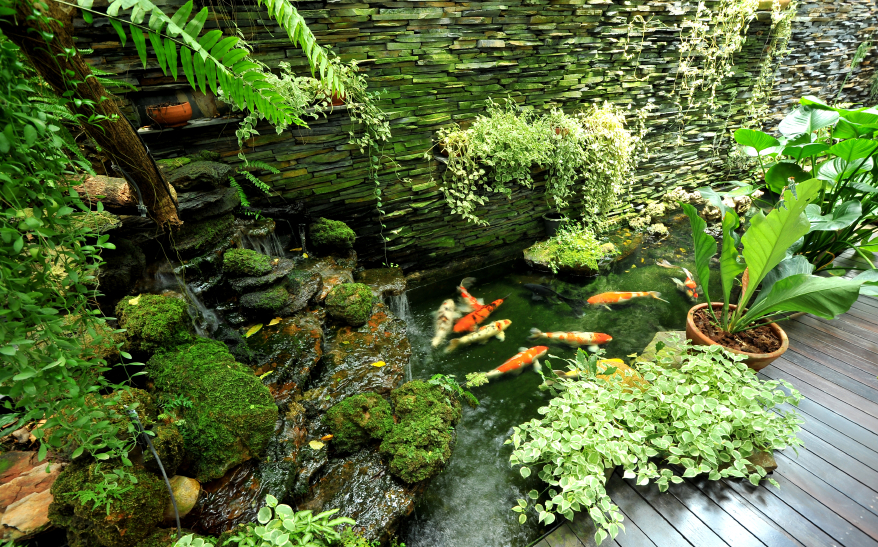Caring for Koi Ponds
Every thirty seconds, a koi pond is Pinned. Okay, I made that up, but seriously, does anyone else feel like koi ponds are the new "it" thing in landscaping and garden design? Obviously, they’re beautiful, and they combine all the great parts of water features and gorgeous creatures in the garden, but don’t they kind of look like a maintenance nightmare waiting to happen? I’m imagining algae explosions, all my fish being eaten, plants running amok, and zombie uprisings from below.

So what’s the scoop on koi pond maintenance? Is it really as easy as some DIYers seem to make it out to be? Well, the short answer is ... kinda, if your pond was built right in the first place and you’re willing to dedicate 5-10 minutes a week to caring for your pond, and your fish. But, and here’s the important caveat, there are some times where you’ll have to take on more serious maintenance tasks in caring for koi ponds.
Build Carefully
Let’s start with the basics: building. A koi pond isn’t just a plastic tub with some fish in it. Because it contains a delicate ecosystem of fish, plants, and beneficial bacteria, it needs to be designed and built with care. It should be at least 3' deep, with a dug-out design sloping towards a bottom drain that will feed to a filtration system. Before installing a liner, a layer of insulation (like carpeting, sand, or fine rock) should be installed to prevent zombie attacks—and roots.
Install a Good Filtration System
And that filtration system is critically important. If koi ponds aren’t filtered correctly, the water can become a haven for bacteria and algae, which is bad for the fish, as well as unpleasant for us humans to look at. The bottom drain should head to a vortex filter that swirls the water, flinging muck out to a collection chamber and passing the water through a series of mechanical and biological filters. From there, the cleaned water can be cycled back up through a waterfall to keep it clear, oxygenate it, and add some sound effects.
Maintain the Filters
Those filters need to be periodically cleaned out; it usually takes just a few minutes, but once every week to two weeks, you will need to open up the filtration system, remove debris, and hose off any mechanical filters to make sure they won’t clog. You may also need to add beneficial bacteria if the balance of the pond is off, as can happen if you need to treat for parasites and other health problems. The same bacteria can also be added directly to the koi pond to help support a healthy environment.
Skim off Debris
In addition to a filtration system, you’ll want a skimmer that automatically pulls circulating debris in from the top of the pond. Fallen leaves and other materials are sucked into the skimmer filter to keep the water clear, and the skimmer basket can be easily emptied when you clean the other filters. Furthermore, you might want to consider adding some naturally filtering plants, but be ruthless when it comes to dividing and pruning aquatic plants to keep them from taking over.
Keep the Water Clean
Keep that water in good shape by making sure the pond is filled to the right level; you can run a hose while you clean the filters each week. You may need to partially or totally drain the pond in the fall for cleaning, in which case it’s important to house the koi in their old pond water for at least two weeks to let the new water settle. Furthermore, regular pH testing is advisable to check for indicators that the water may be harboring an infection.
Limit Algae and Keep out Predators
You are inevitably going to end up with some algae; that’s actually desirable, as part of the pond environment, but it should stay in control with proper maintenance. You can help by establishing your pond in the shade, as algae need sun to grow. Shade also provides temperature control and cover from predators like birds, making it harder for them to spot tasty snacks waiting for their attentions. For additional protection, wired pond covers are available to keep greedy beaks, claws, and paws out of the water.
Control the Koi Population
Controlling the koi population is the final and key element to keeping a koi pond looking good. Too many fish can contribute to algae blooms and muddy the waters. Make sure they’re only fed about a handful of fish food a day—yes, even if they beg for more—and don’t be afraid to sell or trade fish to stabilize your population at a set amount. Even though it might be sad to get rid of fish, keeping the overall numbers down will be better for everyone.
Feeling dizzy? It’s okay. Koi ponds do require some serious commitment on your part. Fortunately, there are a lot of enthusiast organizations to help out. They love new members, and often provide mentoring, tips, and advice based on their long experience. Consider checking them out before you take the plunge.
s.e. smith writes for Networx.com.
Updated December 16, 2018.
Looking for a Pro? Call us (866) 441-6648

Landscaping Average Costs
Landscapers Experiences

Lawn Repair: Contractor Followup To My DIY Prep Got The Job Done

Oak Tree Planting Looks Great In Our New Home’s Spacious Yard



